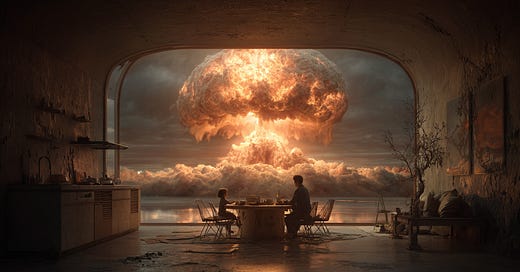The Unthinkable Reality: What Nuclear Preparedness Actually Looks Like in 2025
Inside the minds and bunkers of people preparing for humanity's worst-case scenario
The Soccer Mom with a Geiger Counter
Sarah Groves never thought she'd own a Geiger counter. The software engineer from suburban Denver bought her first radiation detector last spring, tucked between purchasing organic groceries and her daughter's soccer cleats on Amazon. The purchase felt surreal, like buying a fire extinguisher for a house that might burn down, except the house is civilization itself.
Groves represents a growing demographic that preparedness experts are calling "rational catastrophists"—ordinary people making extraordinary preparations for nuclear conflict. Unlike the stereotype of bunker-dwelling survivalists stockpiling ammunition and canned goods, these modern preppers are teachers, accountants, and IT professionals who've done the math on nuclear risk and decided that ignoring it is no longer rational.
The numbers are sobering. The Bulletin of Atomic Scientists moved their Doomsday Clock to 90 seconds to midnight in 2023—the closest it's ever been to symbolic nuclear catastrophe. With over 13,000 nuclear weapons in global arsenals and rising geopolitical tensions involving nuclear powers, nuclear preparedness has shifted from fringe paranoia to uncomfortable pragmatism.
This shift represents more than just individual anxiety. It reflects a fundamental change in how educated, middle-class Americans view global stability. For decades, nuclear war seemed like a relic of the Cold War, something that belonged in history books and Hollywood movies. The current generation of preppers grew up believing that mutual assured destruction had made nuclear conflict impossible. They're now confronting the reality that nuclear weapons haven't disappeared—they've proliferated and become more sophisticated.
The modern nuclear threat landscape is vastly different from the binary standoff of the Cold War. Today's nuclear risks include tactical weapons, dirty bombs, accidents involving aging nuclear infrastructure, and the potential for limited exchanges that could escalate rapidly. This complexity demands a more nuanced approach to preparedness that goes far beyond the traditional bunker mentality.
When Nightmares Move Into the Suburbs
The psychological profile of today's nuclear preppers defies easy categorization. They're not survivalist extremists or religious end-times believers. They're more likely to have advanced degrees, work in technical fields, and approach preparedness with the same methodical thinking they apply to retirement planning or home insurance.
Dr. James Morrison, a nuclear physicist turned preparedness consultant, spends his days helping people understand what nuclear survival actually entails. His clients aren't stockpiling beans and ammunition. They're installing whole-house HEPA filtration systems, creating neighborhood mutual aid networks, and grappling with questions that would have seemed absurd a generation ago: How do you explain radiation exposure to a six-year-old? What happens to your mental health after months in isolation? How do you rebuild trust in a world where governments failed to prevent nuclear war?
The psychology of nuclear preparedness, Morrison has observed, is as complex as the physics. The radiation will kill you, but the isolation, depression, and social breakdown might kill you first. Modern nuclear preppers aren't just preparing for nuclear war—they're preparing for the collapse of meaning itself.
This psychological dimension separates contemporary nuclear preparedness from other forms of emergency planning. Hurricane preparedness is about weathering a specific event with a clear beginning, middle, and end. Nuclear preparedness forces people to confront the possibility of permanent change—the end of the world as they know it and the beginning of something unprecedented and terrifying.
The mental health implications are profound. Many preppers report experiencing a form of anticipatory grief, mourning the loss of a future that might never come to pass. They describe feeling isolated from friends and family members who view their preparations as excessive or paranoid. Some struggle with what psychologists call "survivor guilt," feeling guilty about their ability to prepare while others cannot.
Yet paradoxically, many also report experiencing a sense of peace and empowerment through preparation. The act of taking concrete steps to protect their families provides a sense of agency in the face of global forces beyond their control. This psychological benefit may be as important as the practical benefits of their preparations.
Keep reading with a 7-day free trial
Subscribe to Asymmetric Winning to keep reading this post and get 7 days of free access to the full post archives.





